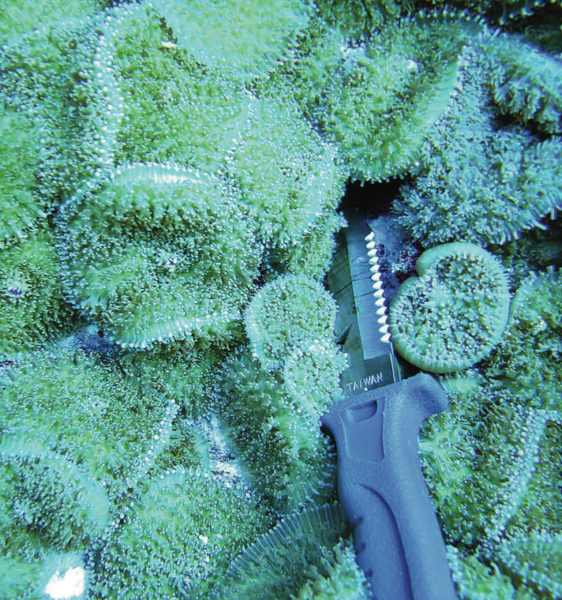Published in the Ocean Watch column, Honolulu Star-Advertiser © Susan Scott
February 1, 2020
While at Midway recently we workers enjoyed evening talks by people with various experiences and areas of expertise.
One U.S Fish and Wildlife Service biologist, Tim Clark, gave a slide show about a corallimorph species growing over, and smothering, some of Palmyra Atoll’s hard corals.
“Interesting talk,” my seabird biologist friend said afterward. “But what’s a corallimorph?”
Good question. Corallimorphs (cor-AL-eh-morfs) have no common name, and although the word “coral” is in their name, and they resemble anemones, corallimorphs are their own order of marine animals.
 A cluster of corallimorph grows in abnormally high densities off
A cluster of corallimorph grows in abnormally high densities off
Palmyra Atoll. Each disc can curl its edges into a fleshy sac to engulf its prey.
Poisonous tentacles around the disc’s edges kill corals settling nearby.
A dive knife sits in the cluster for scale.
Photo from USGS.
About 50 corallimorph species exist throughout the world’s oceans. Although the creatures range from shallow to deep water and from pole to pole, most are tropical. Deep-sea corallimorphs can grow to 3 feet across, but warm- water species range in size from barely visible to several inches in diameter.
Hawaii hosts only two kinds of corallimorphs, one about one-eighth inch in diameter, the other about a half-inch in diameter. The animals are so rare and hard to find here they have yet to be officially named.
Corallimorphs vary with region, but most look like flat, roundish discs. The lower surface of the animal is smooth, but its upper surface has short, toxin-tipped tentacles. The mouth at the center of the disc is upturned, as opposed to anemones’ mouths, which tunnel down.
Like their coral and anemone cousins, corallimorphs host algae in their tissues, giving the animals carbohydrates and color. Also like their above relatives, corallimorphs are carnivores, capturing and eating passing animal plankton.
Corallimorphs are notorious for settling into disturbed areas on coral reefs and then dominating the area.
That’s what happened after a longline fishing vessel hit Palmyra’s reef in 1991 and sank about 25 feet down. Not much happened at the site until 2005 when researchers noted that the native corallimorph, Rhodactis howesi, had multiplied around the ship’s hull to the extent that it was blanketing, and killing, the corals beneath it.
One theory as to the corallimorph’s spread was that iron leeching from the ship’s hull contributed to the species’ rapid reproduction. After officials removed the wreck in 2013, the corallimorph’s growth around the ship greatly slowed, but the creatures had increased in other areas around the atoll. Work on controlling the spread is ongoing.
In the home aquarium trade, the corallimorph species Rhodactis howesii, which is carpeting over some corals on Palmyra’s reefs, is known as the green fuzzy mushroom coral or green hairy mushroom coral. Except it’s neither a mushroom nor a coral, and it isn’t fuzzy or hairy.
And in that is one answer to, “What’s a corallimorph?” The creatures have no good common name.